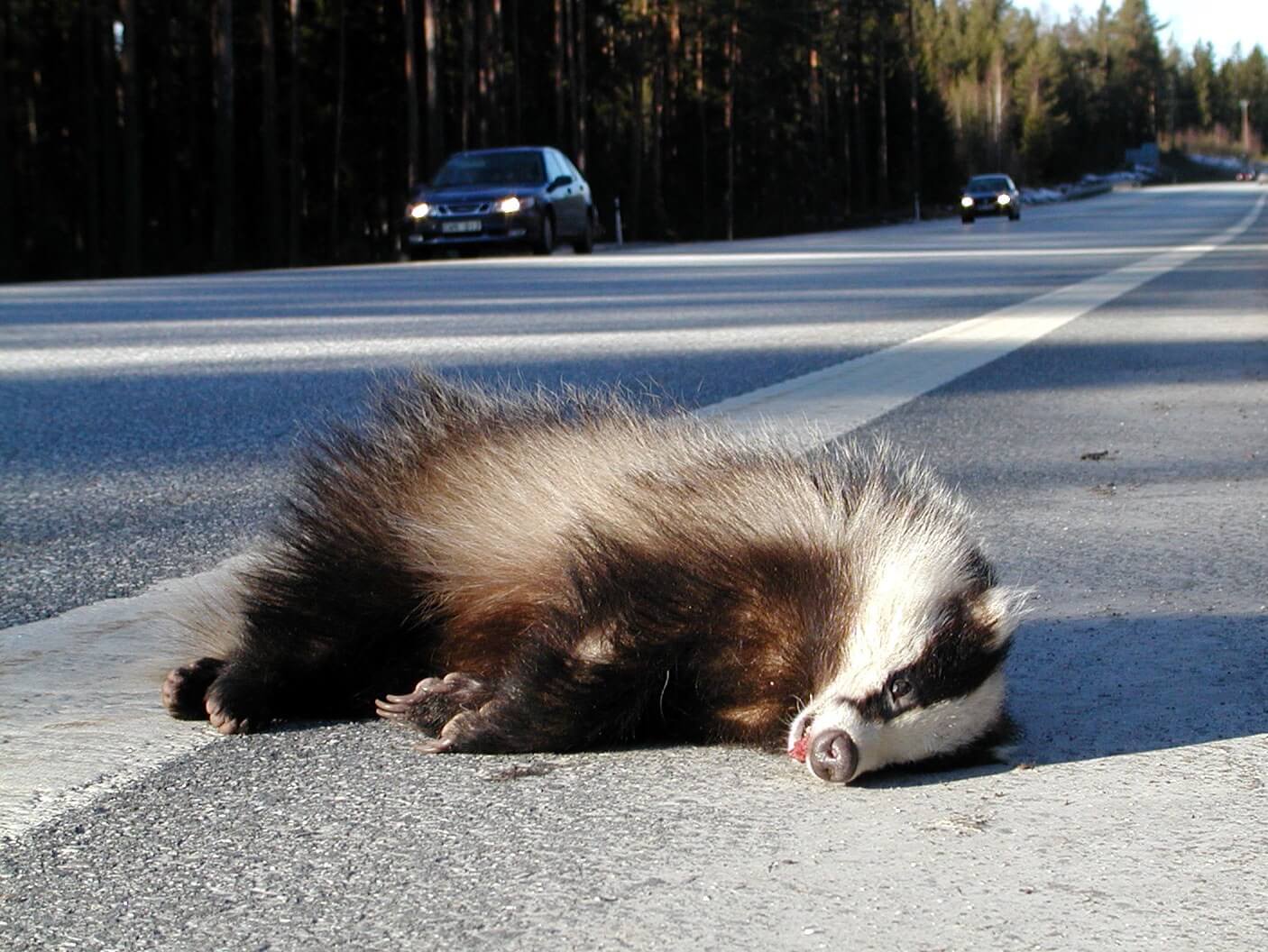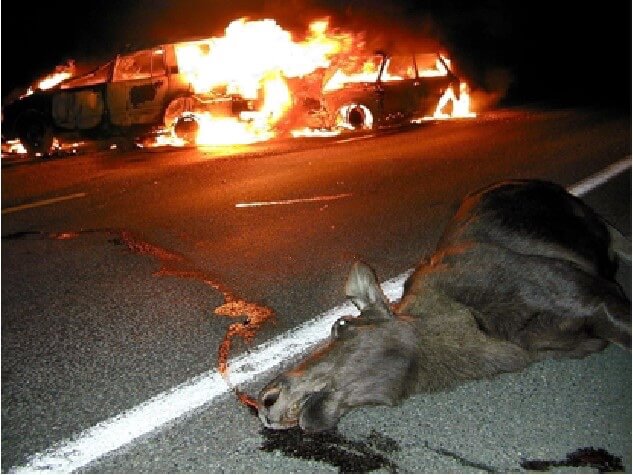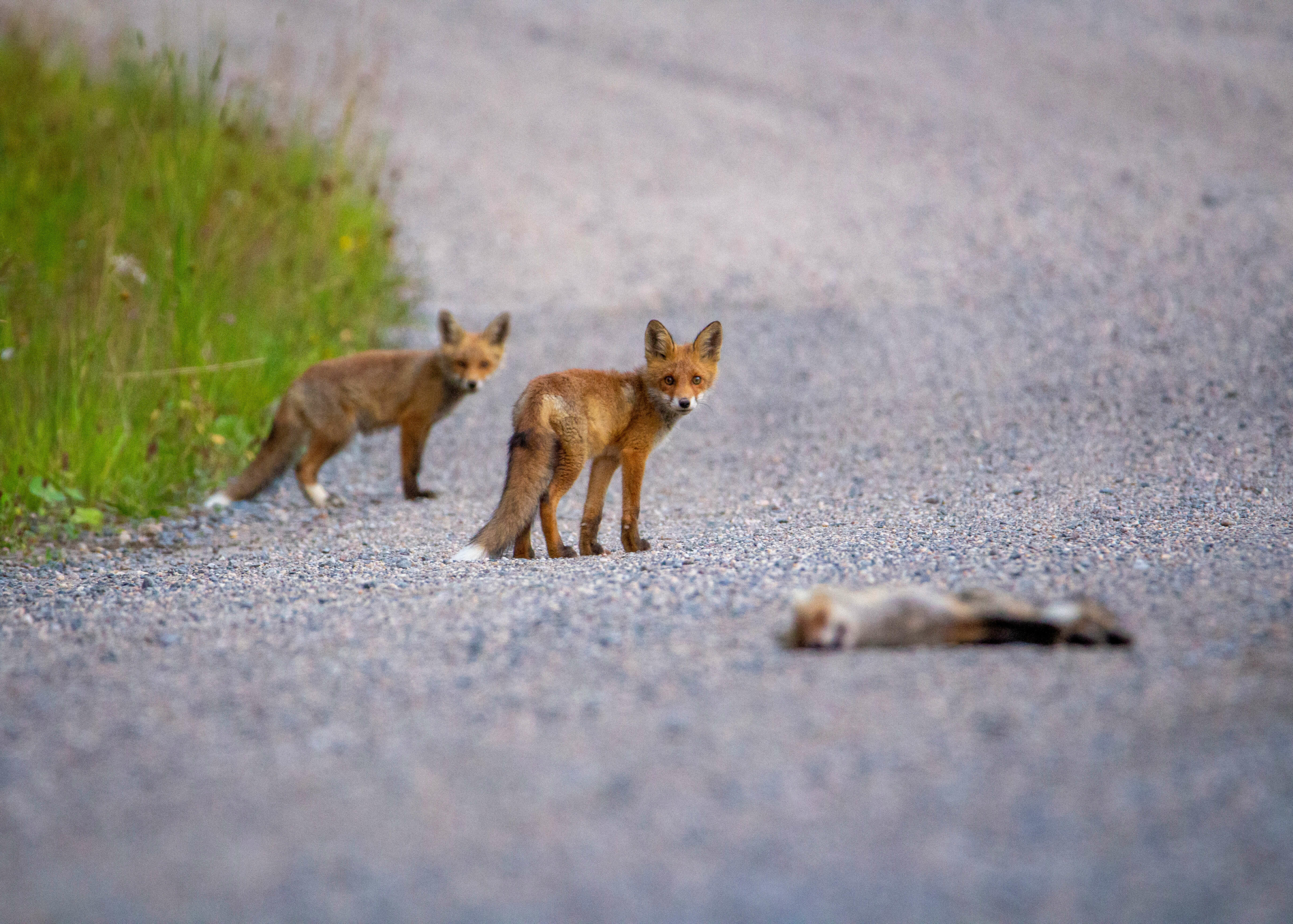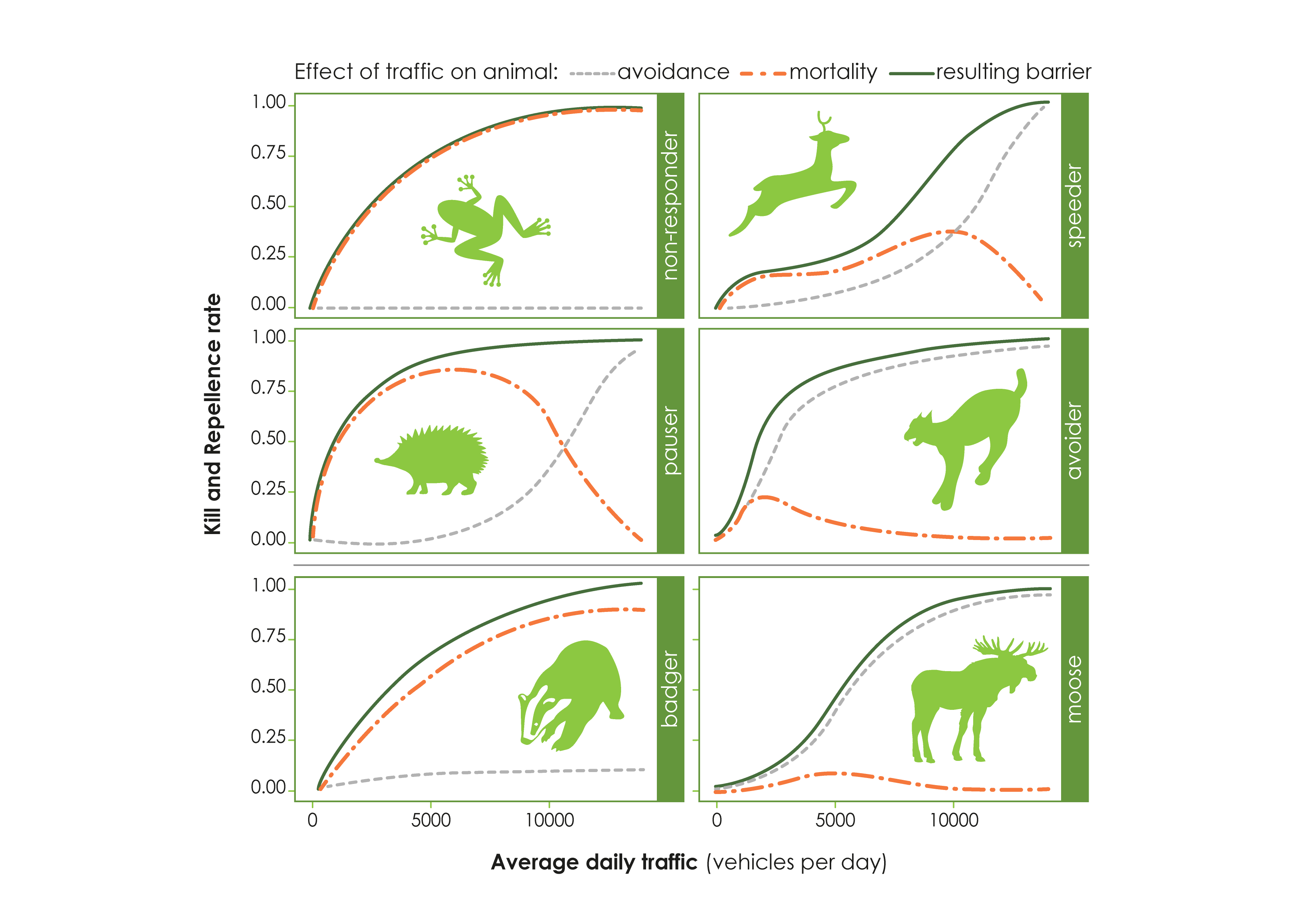Traffic and infrastructure have likely become the most significant human-induced cause of wildlife injury or mortality (Figure 1.3.3). Each year across Europe, it is known millions of mammals, amphibians, reptiles, birds and an unquantifiable number of invertebrates die due to traffic and infrastructure.
Animals are killed on infrastructure due to a multitude of factors, including:
- Collision with vehicles (with cars, trains, airplanes).
- Electrocution on powerlines and conductor posts (often birds of prey).
- Collision with wires in railway catenaries or powerlines.
- Entrapment in protective fences (mammals, fowl).
- Collision with transparent noise protection screens (birds).
- Drowning in canals (all wildlife).
- Collision with airplanes (mainly bird and bat strikes).
- Culling for traffic safety (e.g., at airports).
- Increased predation along road or railway verges (e.g., small mammals, reptiles).
- Exposure to sun, dust, poison, noise. (e.g., amphibians, fish, birds).
- HTI or ROW management practices such as vegetation removal, mowing, drainage.

Most animal deaths are unintended, go unnoticed and have no effect on infrastructure operation. Therefore, traffic mortality has long been overlooked and accepted as a side-effect of transport. However, research has provided comprehensive evidence for the magnitude of this threat and raised public awareness on the need for mitigation. Reducing wildlife mortality from traffic and infrastructure is now an urgent challenge for ecological, societal, legal, and ethical reasons.
From an ecological point of view, many wildlife populations are already under significant pressure due to habitat destruction, climate change, and other human activities. The additional damage caused by vehicles and infrastructure can have severe impacts on already vulnerable populations, pushing these to the edge to local extinctions, reducing genetic diversity and making the species more vulnerable to future threats. The loss of individual species, especially apex predators, can have cascading effects on the entire ecosystem, potentially leading to imbalances and ecosystem collapse.
From a societal perspective, reducing wildlife mortality due to transport infrastructure can improve road safety and safe money in property damage, healthcare costs, and productivity losses. Furthermore, it can also enhance the quality of life of local communities by preserving the natural heritage and traditional land use practices such as nomadic herding.
From a legal perspective, many countries have regulations in place to protect wildlife and their habitats. The European Habitat Directive, article 12, no longer tolerates even incidental killing of endangered species, be it in traffic, on infrastructure, or due to other related activities. This Directive is intended to protect and conserve wildlife species and their habitats, which is essential for maintaining a healthy and resilient ecosystem. Signatory countries are legally obliged to ensure that their actions do not entail incidental and avoidable killing. Non-compliance can result in legal penalties and economic costs.
Authorities must, when and where deaths may occur, take necessary countermeasures. This, in turn, requires regular monitoring and evaluation of wildlife mortality – a responsibility for infrastructure managers (see Chapter 6 – Evaluation and monitoring).
Finally, reducing wildlife mortality due to transport infrastructure is a matter of moral and ethical responsibility. It is crucial to take proactive steps to protect wildlife, preserve ecosystems, and ensure the safety of all species – not only humans (Figure 1.3.4).
By implementing appropriate measures, the impact of transport infrastructure on wildlife, can be reduced to improve traffic safety and transport operations and promote the coexistence between humans and animals (see Chapter 5 – Solutions to mitigate impacts and benefit nature).
Traffic safety and economy
Wildlife mortality due to traffic and infrastructure can have significant economic impacts, particularly with respect to the costs associated with accidents, human injuries, damage to vehicles and infrastructure and delays in traffic (Figure 1.3.5). Bird strikes at airports as well as vehicle collisions with larger ungulates such as moose, deer, or wild boar, have become common place in many European countries. For example, in Sweden, over 70,000 accidents with ungulates are reported every year, producing a societal bill of more than 1 billion €, many hundreds of injured people and several human fatalities. Accidents with ungulates account for over 60% of all police-registered traffic incidents and are a major cause of concern for train drivers. Similar numbers are reported from other countries in Europe and the trends point upwards, suggesting that the problem will continue to grow. Even though ~ 95% of these accidents only lead to property damage, the combined societal costs are significant and should justify the installation of mitigation measures such as fences and wildlife passages, and other more flexible measures (see Chapter 5 – Solutions to mitigate impacts and benefit nature).
However, the existing data and impacts on large mammals may not apply to most of the smaller fauna which includes endangered species of amphibians, bats, or small carnivore, that have different ecology, life-history, and behaviour. This is partly due to a general lack of data for these species and, to a lack of economic incentive for mitigation. Without human or vehicle impacts, the arguments for investing in mitigation must rely on ecological, ethical, and political perspectives as well as on legal obligations that are in place to compel authorities to act for threatened species (see Habitat Directive, article 12).

Effects on wildlife
Several studies indicate that the impact of traffic and infrastructure on wildlife can be detrimental and long-lasting for both rare and abundant species. Species that are impacted most from traffic mortality share these common characteristics:
- Highly mobile, occur at low densities, have large home ranges (compared to the size of the infrastructure network).
- Long-lived, delayed maturity and have low reproductive rates (limiting their ability to quickly replace individuals lost to traffic mortality).
- Exert seasonal migrations that lead large parts of the population across infrastructure (e.g., amphibians, ungulates, and bears).
- Attracted to infrastructure through scavenging on fauna carcasses and/or on human waste, feeding on grain spill, or preying on reptiles and small mammals in verge habitats. All these activities increase exposure to traffic.
- Use transport infrastructure as conduits, dispersal corridors or for other purposes,
- Show specific behaviours and lack cognitive abilities that make them more vulnerable (e.g., low sensitivity to the traffic).
In rare species, even a small number of individuals lost due to traffic or infrastructure can have a significant impact on the population. This is because these species already have low population sizes and are at risk of extinction due to other factors, such as habitat loss and fragmentation. The loss of even a few individuals can exacerbate these existing threats, leading to a decline in populations and even local extinctions.
In abundant species, mortality due to traffic and infrastructure may seem less severe but can still be significant. These species may be able to compensate for a certain level of mortality without experiencing significant population declines, but continued mortality can lead to cumulative impacts over time. Furthermore, the loss of individuals can affect the genetic diversity of local populations, which can impact their ability to adapt to changing environmental conditions. Moreover, increased mortality can also result in changes to the structure and function of ecosystems, especially when certain species such as apex predators are involved that otherwise play important roles in food webs or in regulating populations of other species.
Overall, mortality caused by traffic and infrastructure can have significant population-level effects on wildlife, with the impacts varying depending on the species’ abundance and other threats they may be facing. The degree of mortality may be difficult to assess as the occurrence of carcasses along infrastructure can be misleading. For example, few fatalities can indicate both a high vulnerability due to an already small population size, and a low vulnerability if the species in question is able to avoid collisions. Thus, monitoring of wildlife fatalities along infrastructure is important, but must be related to estimates of the local as well as regional population status.
Contributing factors
Wildlife mortality due to traffic and infrastructure is influenced by various factors, including traffic volume and animal abundance. Infrastructure and its facilities may attract foraging animals in search of prey, or other resources such as resting poles, nesting grounds, and shelter. For example, reptiles may bask on sunlit asphalt, toads may seek shelter between rails and gravel on railway tracks, mice may burrow in the sandy soil of road verges, and birds of prey may use powerline posts or road signs to hunt for small mammals. Attractive infrastructure corridors expose species to traffic dangers, especially if roads or railways are accessible and not physically separated from their surroundings. Infrastructure managers can control and mitigate traffic mortality in wildlife by managing the attractiveness and accessibility of infrastructure corridors.
In addition, certain behavioural and cognitive traits make some species more sensitive to traffic than others (Figure 1.3.6). For instance, larger mammals that can identify vehicles and recognise danger may be better equipped to avoid accidents. In contrast, species such as amphibians that lack the cognitive skills to detect passing vehicles may be unable to avoid being run over. Some species, such as hedgehogs or badgers, may stand in the face of danger, while others, such as deer, may rely on their speed to evade predators. However, these strategies may not work when confronted by vehicles and rather increase collision risks. As a result, the relationship between traffic volume and traffic kills is not linear nor always positive. For example, collision statistics with deer in Scandinavia decrease on very busy roads, suggesting that heavy traffic repels animals from attempting to cross and thus reducing collisions. Most accidents occur on intermediate county roads with traffic volumes ~ 5,000 vehicles per average day, where sufficiently long intervals between cars may not deter animals from entering the road.
Wildlife mortality due to traffic and infrastructure is the result of many cascading probabilities, ranging from species abundance in adjacent habitats, landscape composition and the relative attractivity of the infrastructure corridor, the accessibility of the driveway, traffic flow and speed, and the behaviour of both drivers and animals.
Preventing accidents must therefore involve multiple stakeholders and is not the sole responsibility of the transport sector. While infrastructure managers can design and maintain roads, railways, or other facilities in such a manner that animals and traffic are safely separated in space or time, landowners may contribute through appropriate habitat management, and vehicle drivers by increased alertness and reduced speed, and local authorities by temporal or local traffic calming. Mitigation options are many as is described in Chapter 5 – Solutions to mitigate impacts and benefit nature.

